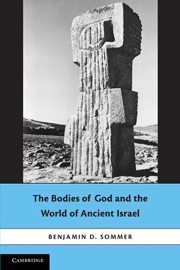Book contents
- Frontmatter
- Contents
- Preface
- Acknowledgments
- Introduction: God's Body and the Bible's Interpreters
- 1 Fluidity of Divine Embodiment and Selfhood: Mesopotamia and Canaan
- 2 The Fluidity Model in Ancient Israel
- 3 The Rejection of the Fluidity Model in Ancient Israel
- 4 God's Bodies and Sacred Space (1): Tent, Ark, and Temple
- 5 God's Bodies and Sacred Space (2): Difficult Beginnings
- 6 The Perception of Divinity in Biblical Tradition: Implications and Afterlife
- Appendix: Monotheism and Polytheism in Ancient Israel
- Notes
- List of Abbreviations
- Bibliography
- Scriptural Index
- Index of Rabbinic Citations
- Subject Index
1 - Fluidity of Divine Embodiment and Selfhood: Mesopotamia and Canaan
Published online by Cambridge University Press: 15 September 2009
- Frontmatter
- Contents
- Preface
- Acknowledgments
- Introduction: God's Body and the Bible's Interpreters
- 1 Fluidity of Divine Embodiment and Selfhood: Mesopotamia and Canaan
- 2 The Fluidity Model in Ancient Israel
- 3 The Rejection of the Fluidity Model in Ancient Israel
- 4 God's Bodies and Sacred Space (1): Tent, Ark, and Temple
- 5 God's Bodies and Sacred Space (2): Difficult Beginnings
- 6 The Perception of Divinity in Biblical Tradition: Implications and Afterlife
- Appendix: Monotheism and Polytheism in Ancient Israel
- Notes
- List of Abbreviations
- Bibliography
- Scriptural Index
- Index of Rabbinic Citations
- Subject Index
Summary
Religious thinkers of the ancient near east viewed gods and goddesses as radically unlike human beings in ways that may seem baffling to people in the contemporary Western world. In the eyes of Babylonians, Assyrians, Canaanites, Arameans, and Egyptians, a single deity could exist simultaneously in several bodies. Further, a deity could have a fragmented or ill-defined self, for gods were not fully distinct from each other, at least not all of the time. (By “a self,” I mean a discrete conscious entity that is conscious of its discrete nature.) We can contrast this perspective with another one, which is evident in data from archaic and classical Greece. Greek culture provides no evidence that multiple objects could contain the presence of a particular deity at any one moment. Ancient Greek religion furthermore maintained that deities' selves were consistently distinct from each other. Each cultures' perception of gods' bodies, then, reflects its understanding of gods' selves. These two ways of perceiving divinity present us with two types of answers to the question, “Are deities fundamentally similar to humans or fundamentally different from them?” For the Greeks, a god, like a human being, had a discrete body and a discrete self. For ancient Near Eastern religions, gods could have multiple bodies and fluid selves. Greek religion assumed a basic resemblance between mortals and immortals in this respect, whereas ancient Near Eastern religions posited a radical contrast between them.
This assertion may come as a surprise to many students of antiquity.
- Type
- Chapter
- Information
- The Bodies of God and the World of Ancient Israel , pp. 12 - 37Publisher: Cambridge University PressPrint publication year: 2009



